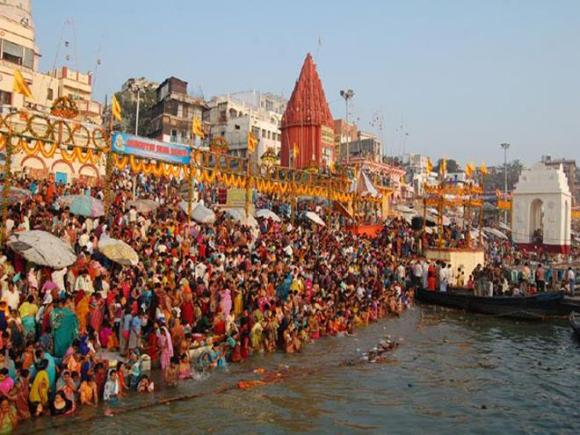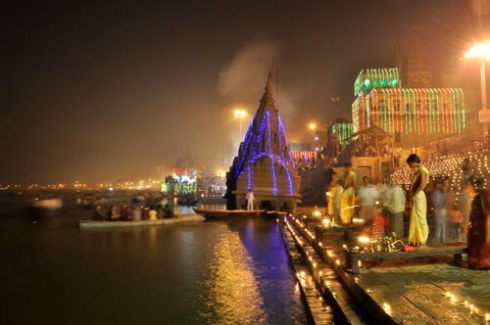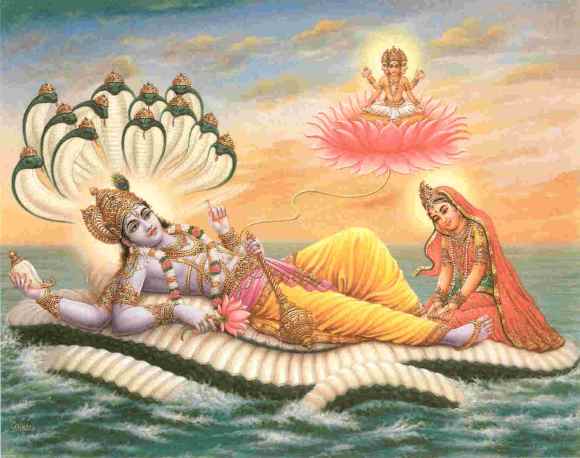
: A scene of the Hari-ki-Pauri in Haridwar on the occasion of Karthik Poornima
Kartik Poornima , as the names implies , is celebrated on the full moon day of Kartika month. It lies on the fifteenth lunar day of the Kartika (November-December). It is known by multiple names, few of them are Tripuri poornima, Tripurari Poornima, Deva-Diwali, or the Deva-Deepawal. This day is marked by special Puja and Yajnas to Lord Vishnu and Harihara. It is believed that performing puja to Lord Vishnu brings a devotee closer to salvation, on this day. It is observed greatly by the Hindus and Jains.
This day is marked at several places by various festivals and rituals. In the northern India, Punjab celebrates this day as Guru Purab(Guru Nanak Jayanti). In the state of Rajasthan , Pushkar mela(Asia’s largest camel fair) in Pushkar ends on this day. In the state of Bihar, begins the Asia’s largest cattle fair, Sonepur Mela . In Odisha, this month has a special significance. People observe the special rituals very religiously. They avoid taking the non-vegetarian food for the entire month. Widows again perform a strict routine in their food. They take only arwa rice alongwith moong daal, believed to be pure and doesn’t distract a person in devoting self towards a spiritual goal(Saadhna). Bali Yatra, a procession taken out on this day commemorates Orissa's ancient maritime. In Varanasi, the ghats come alive with thousands of earthen lamps(diyas). People gift lamps to priests. The lamps are kept throughout the night in houses and Shiva temples. This day is also known as "Kartik Diparatna" - the jewel of lamps in Kartik. Lights are also floated in miniature boats in rivers. Lights are placed under Tulsi, sacred fig and amla tress. It is believed that it help fishes, insects and birds who saw the light to attain salvation(free from the cycle of life and death).
Mythological Aspect :
In Ancient times, Tripurari (an epithet of Shiva ) killed the demon Tripurasura. He was a mighty , mystical and a very magical demon, who had conquered the entire universe , defeated Indra(King of Gods) and had taken the heaven. He also created three cities in space, together called "Tripura". This was the day when Shiva(the destroyer of evil) had killed the demon. It led to the end of the magical aroma that was build by the demon in the universe. His killing led to the enormous lightening all over. Gods were overjoyed and marked the day as their Diwali, better known as the Dev-Dipawali.

:Dev-Deepawaali , a beautifull view of the Varanasi Ghats.
Kartik poornima is marked as the day when god Vishnu incarnated as the Matsya(fish avatar). It is also the birthday of Vrinda, the personification of the goddess Tulsi(sister in law of god Vishnu). Kartikey, son of God Shiva and the god of war was also born on this auspicious day. This day also is considered dear to Radha Rani, the lover of Krishna - Vishnu's incarnation. It is believed that Krishna and Radha danced the famous rasa on this day into the forests of tulsi, Vrindawan. This day is also dedicated to the Pitrs, our forefathers.
The festival has more significance when the day falls in the lunar mansion Krittika and is then called Maha Kartik. On this day, it is believed that god Vishnu again goes off to sleep, into the deep sea (Chheer Sagar) on to the pyre of Shes-Naag, with goddess Laxmi sitting by the side.

: Lord Vishnu, Goddess Laxmi and Shes-Naag .
In India, there is a common tradition of taking bath at a holy river on this particular day. That is why on the day of Kartik Purnima, we find a huge crowd on the banks of holy rivers, especially Ganga as well as Yamuna. However, there are many other pious rivers like Saraswati, Narmada, Godavari, Kurukshetra, Ayodhya, Kashi and many more. Glory of taking bath on the day of Kartik Purnima has also been described by the holy Vedas as well as Puranas. If a river is not possible, then taking bath at any other water body is considered auspicious, especially while remembering the name Lord Vishnu. It is believed that people who do such deeds get blessings from the Almighty.
Another belief states that taking bath in a sacred river by following proper religious procedures helps the devotee attain salvation at the end. Other than spiritual beliefs, month of Kartik has some scientific boons too. Month of Kartik falls at the time of seasonal change. And, if a person takes shower early in the morning during this month, this helps him to adjust with the upcoming season easily and fills his body with immense energy throughout the whole day. This helps in adjusting our body’s immunity to adjust with change in season.
First thing that is quite famous for this day is that donating anything on Kartik Purnima is equivalent to 100 Ashvamedha Yagyas. As per the beliefs of Hindus, charity or donation on this day leads the individual toward the way of salvation.
Jains :
Kartik Poornima is an important religious day for Jains who celebrate it by visiting Palitana one of the most famous Jain pilgrimage centre. Thousands of Jain pilgrims flock to the foothills of Shatrunjay hills of Palitana taluka on the day of Kartik Poornima to undertake the auspicious yatra (journey). Also known as the Shri Shantrunjay Teerth Yatra, this walk is an important religious event in the life of a Jain devotee, who cover 216 km of rough mountainous terrain by foot to worship the Lord Adinath temple atop the hill.
Considered as a very auspicious day for Jains, the day also assumes significance for the walk as the hills, which are closed for public during the four months of monsoon, are thrown open for the devotees on Kartik Poornima. The day of Kartik Poornima holds significance in Jain religion and devotees are kept away from worshipping their lord for four months of monsoon and hence the first day attracts the maximum number of devotees.
May this day bring enormous joy to all of us and lead us to the path of attaining salvation..!!


















